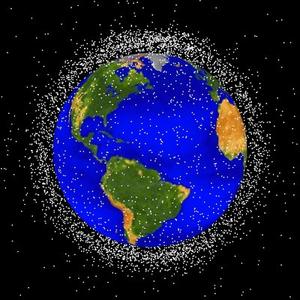Planetary securityDARPA funds giant space nets to scoop up space trash
One legacy of the space age is the growing amount of debris — defunct satellites, fragments of rockets, and any unused object originally built and launched by humans — accumulating in space; currently there are 2,465 identified objects of more than two kilograms in low Earth orbit, and these objects threaten projects such as the space elevator; a futuristic company proposes collecting the debris with a dozen space vehicles, each equipped with 200 nets, which would scoop up the debris and then either fling them into the South Pacific, send them closer to Earth where they would eventually decay, or recycle the materials

Space debris in low-Earth orbit. // Source: nhn.ou.edu
Here is an idea: A dozen space vehicles, equipped with 200 nets each, could scoop up the space debris floating in low Earth orbit, clearing the way for a future space elevator. This is the idea described last Friday at the annual Space Elevator conference by Star Inc., a company that is receiving funding for the project from DARPA.
Techworld’s Nancy Gohring writes that Star Inc. president Jerome Pearson was one of the early pioneers of space elevators; in 1975, Pearson wrote a paper on the subject that inspired Arthur C. Clarke’s description of a space elevator in his popular science fiction book, The Fountains of Paradise. Consisting of a long cable of nanomaterials, a space elevator would stretch from Earth to a point in geostationary orbit about 22,000 miles above the surface, carrying people and objects into space on its shuttles.
One of the biggest obstacles to building a space elevator is space debris: defunct satellites, fragments of rockets, and any unused object originally built and launched by humans that is no longer used. At the conference two years ago, former NASA scientist Ivan Bekey pointed out that, if a space elevator were built, every single piece of space debris would eventually collide with the elevator cables at some point.
Pearson predicts that, over a period of seven years, a dozen of Star Inc.’s Electrodynamic Debris Eliminator (EDDE) vehicles could potentially capture all 2,465 identified objects of more than two kilograms currently floating in low Earth orbit. After capturing the objects, the EDDEs could either fling them into the South Pacific, send them closer to Earth where they would eventually decay, or recycle the materials. As Pearson explained, the aluminum and other materials collected by the EDDEs could be used to build structures that could host crews or store equipment.
In order for the twelve EDDEs to operate safely in space without colliding with one another, Pearson also emphasized the need to have some form of space traffic control. Already, he said, the U.S. Federal Aviation Administration (FAA) is looking into regulating space traffic, such as requiring space vehicles to schedule flight plans.
Star Inc. plans to launch test flights in 2013, and if everything goes well, could start removing trash in 2017. The company is also shifting the project from DARPA to NASA — and possibly later to the UN — to alleviate concerns that the EDDEs could be used for military purposes to remove enemy satellites from orbit.
